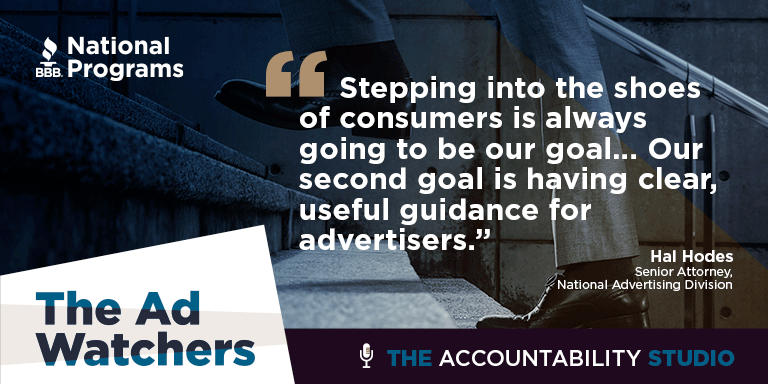
Accountability Studios presents Ad Watchers—a unique podcast series brought to you by the National Advertising Division (NAD) of BBB National Programs. This podcast series provides listeners with behind-the-scenes access and insights into the nitty-gritty of advertising law. In its inaugural episode, hosts Hal Hodes and La Toya Sutton talk about the importance of consumer understanding.
The conversation begins with the dynamic duo teasing up the types of conversations listeners can expect to hear, defining their target listener, and highlighting their goals for the podcast series. As La Toya stated, ultimately, they “want to help the listener know what to do, and what to look for to ensure that their advertising is truthful and substantiated.”
In this episode, Hal and La Toya also answer the question, “who makes the rules.” They start by clarifying that NAD does not contribute to the rule-making process. Instead, they help apply the rules formulated by federal organizations and agencies like the Federal Trade Commission (FTC), Environmental Protection Agency (EPA), and similar entities.
When reviewing an advertising claim, NAD looks to harmonize its decisions with the pre-existing laws and regulatory guidelines to guide its decisions. Throughout this process, their primary goal is to ensure that consumers are “provided with truthful and accurate information.”
Hal and La Toya then walked listeners through how NAD helps provide consistency, so advertisers do not feel like they have to choose between what the federal regulation or NAD says.
- In cases where there is an applicable federal regulation or an agency directly related to the product or claim, NAD will attempt to harmonize its efforts with those of the appropriate regulatory agency.
- They look to regulations for guidance about consumer perceptions of advertising and what evidence is expected when a claim is made.
During their case reviews, NAD recognizes applicable federal regulations and uses them as a guideline for determining consumer interpretation and understanding. They apply the standard set by the federal agency with the trust that it provides a reasonable basis for consumer understanding.
There are some cases, namely certain types of administrative reviews, where NAD does not follow the regulatory guideline. Hal and La Toya explained this is because it does not inherently consider all of the messages that consumers might walk away with.
As the episode came to an end, they highlighted four principles and considerations that NAD keeps in mind when reviewing an advertisement.
- Consumer understanding comes first.
- Understanding if the cited guidance is a potentially “standard-setting” rule or regulation. Or, is it the result of an administrative review, which may not account for all of the potential implied messages conveyed?
- If it is a regulation, does it help us understand what messages consumers would reasonably takeaway?
- Would our understanding of the consumer takeaway contradict the regulation?
At the end of the episode, Hal and La Toya explained that stepping into the consumer’s shoes and ensuring advertisers have clear, useful guidance available to them will always be two of NAD’s primary goals.
Visit to Learn More: NAD FAQ’s
Contact Information: nad@bbbnp.org

